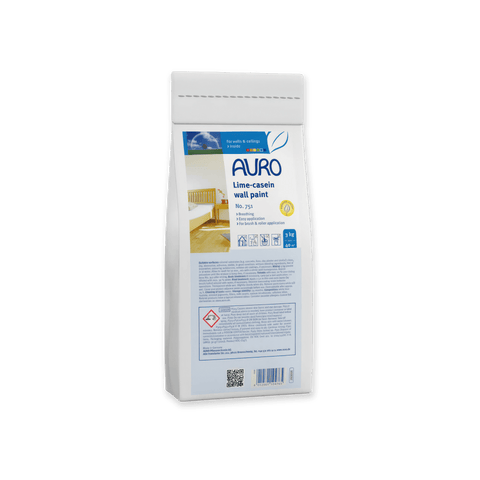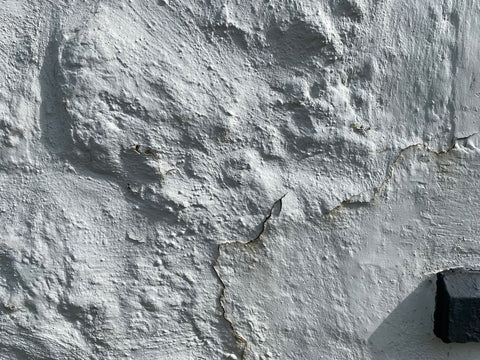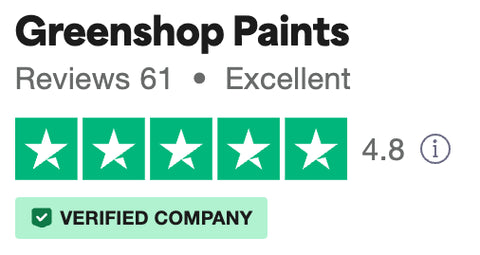Lime paint is made from traditional materials including slaked lime and water, pigments may be added for colour.
This paint type is one of the oldest decorative coatings in existence. It’s use has been documented for centuries, even as far back as Roman times. This traditional paint forumlation is natural, breathable, sustainable and suitable for homes from ancient castles to listed buildings, cottages, and eco-friendly renovations.

There’s lots of terminology to understand around Lime paint. In this guide we’re going to explain which modern lime paints are available, how they work, and where they can be applied for best results.
What is Lime Paint?
Lime paint is a natural mineral based paint for walls. It’s formulated from slaked lime, or Calcium Hydroxide. It’s a highly breathable paint type, making it suitable for walls that need to naturally release moisture such as lime plaster, lime based exterior renders, solid stone, or bare brick.
There are two main types of lime paint: traditional limewash and modern lime paints.
Traditional Lime Paint
Often referred to as limewash, this paint has a thin watery consistency and is formulated from a mix of slaked lime and water. It penetrates and bonds with the surfaces it’s applied to via a chemical reaction process. Limewash usually requires several coats, and has a uniquely soft mottled appearance once dried.
Application takes a degree of skill, and it lacks the durability of modern natural paint formulations.
Modern Lime Paint
Modern lime paint formulations are true to the heritage of limewash, but with performance similar to modern paints, and increased durability.
Brands like Auro and Graphenstone have developed high performance lime paints which are pre-mixed. They make use of natural binders and thickeners for improved application and durability. These paints tend to offer better coverage, and are available in an attractive range of colours. Some even have photocatalytic properties which can help purify indoor air, creating a healthier home environment.
Both traditional and modern lime paints are breathable, environmentally friendly, and suitable for heritage or eco homes. The key difference lies in ease of use, consistency, and performance under modern living conditions.
Properties of Lime Paint
Lime paint has a unique set of properties that make it ideal for heritage renovations, damp-prone buildings and breathable construction.
If you’re researching natural breathable paints, there’s a lot of information to absorb about desirable properties and functions.
Lime paint is:-
- Breathable - allows moisture vapour to pass through to stop damp being trapped.
- Hygroscopic - absorbs and releases moisture, regulating indoor humidity.
- Low SD value - a key measure of breathability.
- Mineral based - no plastics, acrylics or synthetic binders.
- Photocatalytic (in some types) - breaks down airborne pollutants and improves indoor air quality.
- Antibacterial and anti-mould - naturally alkaline, discouraging microbial growth. Many lime based paints can be used in high moisture areas like bathrooms and kitchens.
- Chalky, ultra-matt finish - ideal for preserving the character of period properties and application to textured plaster.
- Compatible with lime plaster, stone, brick and breathable masonry.
Lime Paint Terms Explained
Natural paints come with a lot of overlapping terms, and it’s easy to get confused, especially when words like limewash, chalk paint and casein paint are used interchangeably. Here’s some commonly used paint terms and definitions.
We’ll also cover “lime adjacent” paint types and terminologies you may have read about and explain key differences.
Limewash Paint
The most traditional form of lime paint. Made from slaked lime and water, applied in thin coats. Limewash soaks into the surface and cures by carbonation, often needing several coats for depth of colour. It works best on bare lime plaster, stone or render.
Slaked Lime Paint
Slaked lime is made by adding water to quicklime, causing a chemical reaction that turns it into a soft, workable paste called lime putty. This is the base ingredient in all lime paints.
Slaked lime paint is a broader term that includes traditional limewash but can also refer to thicker, modern lime-based paints.
Chalk Paint
A term often misunderstood, chalk paint should not be confused with popular modern furniture paints.
True chalk paint is mineral based and breathable, but many popular decorative brands contain acrylics and these are not suitable for breathable substrates like lime plaster. Have a look at Auro 326 to understand more about types of chalk paint suitable for use in older buildings.
Casein Paint
Casein paint is a milk protein based paint which can include lime as a key ingredient. This is another very traditional paint type. It’s often supplied in powder form for mixing prior to use. Suitable for use on interior walls and ceilings.
Silicate Paint
You might see terms like lime silicate paint, especially with brands like Graphenstone. These paints combine natural minerals such as lime and potassium silicate, with added ingredients like graphene for extra strength and durability.
They offer excellent breathability, long life, and eco credentials, making them ideal for both interiors and exteriors where high performance is needed.
Where and How is Lime Paint Used?
Lime paint can be used on a wide range of mineral surfaces. Its ability to allow moisture to pass through makes it particularly well suited to older properties that were built without modern damp proof courses or impermeable materials.
Lime paint is suitable as:-
Interior Lime Paint for Walls - Ideal for solid wall homes and breathable surfaces like lime plaster or bare stone. Creates a soft, natural finish and helps regulate indoor humidity.
Natural Anti-Mould Paint - Naturally antibacterial and mould-resistant due to high alkalinity. Suitable for bathrooms, kitchens and cellars. Some modern lime paints (like Graphenstone) also break down pollutants.
Breathable Paint for Lime Plaster Lime paint and lime plaster work together to allow moisture to escape. Prevents damp, mould and blown plaster. Modern acrylic paints, which seal in moisture.
Exterior Lime Paint for Render and Masonry - Suitable for lime render and breathable masonry. Allows trapped water to evaporate and avoids flaking. Graphenstone exterior paints offer weather resistance with full breathability.
FAQs
Can you paint over lime plaster? Yes but it's important to paint with a breathable paint such as lime paint, silicate paint or clay paint. Avoid acrylic and plastic-based paints as they can trap moisture and cause damage.
Can you paint over limewash? You can paint over limewash, but it’s vital to properly prepare the surface to ensure the paint will adhere properly. A breathable lime based paint would be one suitable option.
Is lime paint suitable for bathrooms? Yes. Lime paint’s natural alkalinity helps prevent mould and regulate humidity. Choose a high-quality lime paint with added durability if you're using it in areas with heavy moisture, like shower rooms or poorly ventilated bathrooms.
What’s the difference between lime paint and limewash? Limewash is the traditional, very thin form of lime paint - it’s essentially just slaked lime and water. Lime paint often contains stabilisers or binders for better coverage and modern application, but both are breathable and natural.
Does lime paint smell? Lime paint has a very mild mineral scent but is free from strong odours, solvents and VOCs. It’s suitable for use in homes where air quality and sensitivity are concerns.
See Also: Breathable paint for old houses | Limewash guide | Clay paint guide | Painting on lime plaster | What is casein | Best breathable paint for cellar walls | breathable paint for damp walls
Lime Paint - a Modern Twist on a Timeless Finish
Lime paint is a timeless, breathable and environmentally friendly choice for anyone restoring a heritage home, working with lime plaster or simply looking for a healthier wall finish. Whether you prefer a traditional limewash or a modern formulation with added durability, there’s a natural option to suit your space.
Need help choosing a shade? You can order a free colour chart or buy a colour swatch from us to explore our full range of natural, mineral-based paints.





